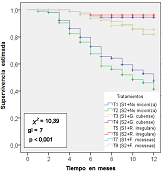Survival of Swietenia mahagoni in the xerophytic corridor of the Guantánamo valley
Main Article Content
Abstract
Downloads
Article Details

This work is licensed under a Creative Commons Attribution-NonCommercial 4.0 International License.
References
ABD EL-KADER, M.M.E., NAGLAA, K., A.-E. y ABO-ELSOUD, I.H. 2016. Effects of Sewage Sludge and Endo- mycorrhizal on Growth, Chemical Content and Some Physical Properties of Swietenia mahagoni seedling. Annals of Agricultural Science, Moshtohor, vol. 54, no. 4, pp. 905-918. Disponible en: https://doi.10.21608/assjm.2016.112675.
AGUIRRE-MEDINA, J.F., YEEKÓN-MÉNDEZ, L. y ESPINOSA-ZARAGOZA, S. 2019. Influencia de hongos endomicorrízicos en el crecimiento de (Tabebuia donnell-smithii Rose). Ecosistemas y recursos agropecuarios, vol. 6, no. 16, pp. 11-21. Disponible en: https://doi.10.19136/era.a6n16.1538.
ÁLVAREZ, P. y VARONA, P. 2006. Silvicultura. 2da. Ed. Editorial Félix Varela. La Habana, Cuba. 246 p.
ÁLVAREZ, P.A. 2017. Métodos Silvícolas. Editorial Universitaria Félix Varela, La Habana, Cuba. 242 p.
BÁEZ-PÉREZ, A.L., LINDIG-CISNEROS, R., VILLEGAS, J., BÁEZ-PÉREZ, A.L., LINDIG-CISNEROS, R. y VILLEGAS, J. 2017. Supervivencia y crecimiento de Fraxinus uhdei, inoculado en vivero, en cárcavas de acrisoles. Madera y bosques, vol. 23, no. 3, pp. 7-14. Disponible en: https://doi.org/10.21829/myb.2017.2331418
BRITO, V.N., TELLECHEA, F.R.F., HEITOR, L.C., FREITAS, M.S.M. y MARTINS, M.A. 2017. Fungos micorrízicos arbusculares e adubação fosfatada na produção de mudas de paricá. Ciência Florestal, vol. 27, pp. 485-497. Disponible en: https://doi.10.5902/1980509827730.
BRUNDRETT, M.C. Y TEDERSOO, L. 2018. Evolutionary history of mycorrhizal symbioses and global host plant diversity. New Phytologist, vol. 220, no. 4, pp. 1108-1115. Disponible en: https://doi:10.1111/nph.14976
CARDONA, W.A., GUTIÉRREZ, J.S., MONSALVE, O.I. y BONILLA, C.R. 2016. Efecto de la salinidad sobre el crecimiento vegetativo de plantas de mora de Castilla (Rubus glaucus Benth.) micorrizadas y sin micorrizar. Revista Colombiana de Ciencias Hortícolas, vol. 11, no. 2: pp. 253-266. Disponible en: http://dx.doi.org/10.17584/rcch.2017v11i2.6109
CREGG, B.M. 1994. Carbon allocation, gas exchange, and needle morphology of Pinus ponderosa genotypes known to differ in growth and survival under imposed drought. Tree Physiology, vol. 14: 883-898.
CHAIYASEN, A., Douds, D.D., Gavinlertvatana, P. y Lumyong, S. 2017. Diversity of arbuscular mycorrhizal fungi in Tectona grandis Linn.f. plantations and their effects on growth of micropropagated plantlets. New Forests, vol. 48, no. 4: pp. 1-16. Disponible en: https://doi:10.1007/s11056-017-9584-6
FALCÓN, E., COBAS, M. y BONILLA, M. 2021. Efecto del sustrato y la micorriza arbuscular en el sistema radical y estado nutricional de Swietenia mahagoni L. Jacq. Revista Cubana de Ciencias Forestales, vol. 9, no. 3, pp. 395-411. Disponible en: http://cfores.upr.edu.cu/index.php/podium/article/view/705
FALCÓN, E., COBAS, M. y BONILLA, M. 2020. Influencia de hongos micorrizógenos arbusculares en el crecimiento y nutrición de Swietenia mahagoni L. Jacq. Hombre, Ciencia y Tecnología, vol. 24, no. Número especial, pp. 25-32. Disponible en: https://www.ciencia.gtmo.inf.cu/index.php/http/article/view/1089.
FALCÓN, E., COBAS, M., BONILLA, M., ROMERO, C. V. 2018. Aplicación combinada de EcoMic® y Fitomas-E® en la calidad de la planta Swietenia mahagoni L. Jacq. Revista Forestal Baracoa, 37 (Número especial), pp. 1-10. Disponible en: http://www.inaf.co.cu/revistas/revista-forestal-baracoa
HERNÁNDEZ, J.A., PÉREZ, J.J.M., BOSCH, I.D. y CASTRO, S.N. 2015. Clasificación de los suelos de Cuba. Ed. Ediciones INCA, Mayabeque, Cuba, 93 p. ISBN 978-959-7023-77-7
Instituto de Meteorología de Cuba [INSMET] 2021. Centro Meteorológico Provincial de Guantánamo. Disponible en: http://www.guantanamo.gob.cu/es/centro-meteorologico-provincial-guantanamo
KAPLAN, E.L. y MEIER, P. 1958. Nonparametric estimation from incomplete observations. Journal of the American Statistical Association, vol. 53, no. 282: pp. 457-481. Disponible en: https://doi:10.1080/01621459.1958.10501452
MARTÍNEZ-GARCÍA, L.B. 2011. Micorrizas arbusculares en ecosistemas semiáridos. Respuesta a factores de estrés ambiental. Revista Ecosistemas, vol. 20, no. 2-3: pp. 117-120. Disponible en: http://www.revistaecosistemas.net/articulo.asp?Id=700
Ministerio de la Agricultura [MINAG]. 2021. Plan de desarrollo de la Unidad Empresarial de Base Silvícola Guantánamo. Empresa Agroforestal Guantánamo. 30 p.
O´FARRILL, A., HECHAVARRÍA, O. y COBAS, M. 2018. Aplicación de la Forestería Análoga en suelos salinizados del Valle de Guantánamo. Revista Avances, vol. 20, no. 2, pp. 141-152. Disponible en: http://www.ciget.pinar.cu/ojs/index.php/publicaciones/article/view/338/1238
OROS-ORTEGA, I., ALONSO-LÓPEZ, A., PÉREZ-MORENO, J., LÓPEZ-COLLADO, J. C., LARA-PÉREZ, L.A., MARTÍNEZ-GARZA, S.E. y ANDRADE-TORRES, A. 2015. Respuesta de plántulas de Cedrela odorata a la inoculación con Rhizophagus intraradices y diferentes niveles de defoliación. Revista mexicana de ciencias agrícolas, vol.6, no. 3: pp. 627635. Disponible en: http://www.scielo.org.mx/scielo.php?scrip=sci_arttex&pid=S2007-09342015000300015
PILIAROVÁ, M., ONDREICKOVA, K., HUDCOVICOVA, M., MIHÁLIK, D. y KRAIC, J. 2019. Arbuscular Mycorrhizal Fungi Their Life and Function in Ecosystem. Agriculture (Pol'nohospodárstvo), vol. 65, no. 1, pp. 3-15. Disponible en: https://doi.10.2478/agri-2019-0001.
PRIETO, J.Á., DUARTE, A., GOCHE TÉLLES, J.R., GONZÁLEZ, M.M. y PULGARÍN, M.Á. 2018. Supervivencia y crecimiento de dos especies forestales, con base en la morfología inicial al plantarse. Revista Mexicana de Ciencias Forestales, vol. 9, no. 47: pp. 151-168. Disponible en: https://doi.org/10.29298/rmcf.v9i47.182
RODRÍGUEZ, V.H., SOTO, A., PÉREZ, J. y NEGREROS, P. 2011. Los hongos micorrízicos arbusculares y su implicación en la producción y manejo de especies neotropicales forestales, con énfasis en meliáceas. Interciencia, vol. 36, no. 8: pp. 564-569. Disponible en: http://www.redalyc.org/articulo.oa?id=33921395002
SALCIDO-RUIZ, S., PRIETO-RUÍZ, J.Á., GARCÍA-RODRÍGUEZ, J.L., SANTANA-AISPURO, E. y CHÁVEZ-SIMENTAL, J.A. 2021. Pinus greggii Engelm.: Respuesta a la inoculación micorrícica controlada y a la fertilización en vivero. Revista Agrociencia, 55:273-290. Disponible en: https://orcid.org/0000-0002-2954-535X
SIGALA, J.Á., GONZÁLEZ, M.A. y PRIETO, J.Á. 2015. Supervivencia en plantaciones de Pinus pseudostrobus Lindl. en función del sistema de producción y preacondicionamiento en vivero. Revista Mexicana de Ciencias Forestales, vol. 6, no. 30: pp. 20-31. Disponible en: http://www.redalyc.org/articulo.oa?id=63442410003
UC-KU, A.G., ARREOLA-ENRÍQUEZ, J., CARRILLO-AVILA, E., OSNAYA-GONZÁLEZ, M.M., ALARCÓN, A., FERRERA-CERRATO, R., LANDEROS-SÁNCHEZ, C., UC-KU, A.G., ARREOLA-ENRÍQUEZ, J., CARRILLO-AVILA, E., OSNAYA-GONZÁLEZ, M.M., ALARCÓN, A., FERRERA-CERRATO, R. y LANDEROS-SÁNCHEZ, C. 2019. Inoculación de hongos micorrízicos arbusculares en el cultivo de Heliconia stricta. Revista mexicana de ciencias agrícolas, vol. 10, no. 5, pp. 1057-1069. https://doi.10.29312/remexca.v10i5.1608.
VALENZUELA, O. 2019. El cultivo sin suelo y la sustentabilidad de las producciones intensivas. En: Aceptad: 2019-04-09T12:32:44Z, Ediciones INTA (Boletín de divulgación técnica), no. 24, pp. 16. Disponible en: http://repositorio.inta.gob.ar:80/handle/20.500.12123/4853.
VILLAMET, P. 2018. Implementación de técnicas de forestería análoga en tres Fincas Forestales Integrales del corredor xerofítico de Paraguay. Revista Hombre, Ciencia y Tecnología, vol. 22, no. 4: pp. 12-25.
WILLIAMS, C.S. 2008. Surviving Survival Analysis. An Applied Introduction. In: SESUG 2008: The Proceedings of the South East SAS Users Group, St Pete Beach, FL. Disponible en: http://analytics.ncsu.edu/sesug/2008/ST-147.pdf.


